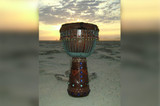Djembe Size Does Matter
Djembe drums come in all sizes, can be rope- or key-tuned and made from wood or other materials like fiberglass. Because of the various options available, buying a Djembe can be a difficult process in itself, especially for a beginning drummer. Even the most seasoned drummer can have a difficult experience choosing a Djembe, especially while drumming in a community environment. Knowing the right size Djembe to enhance the overall sound of a drum circle or performance can make all the difference in the overall sound quality and fun while playing.
The size of the Djembe affects several factors. Most importantly, the size has a direct effect on the comfort of the drummer. While sitting, the Djembe should be able to rest comfortably on the ground, with the head of the drum resting between the knees, about 2”-3” above the legs, allowing for fluid movements and less strain on the back, neck and shoulders. Djembe sizes are measured by the drum head, first, and then the height of the instrument, and while many Djembe sizes are standard throughout the industry, it’s always best to verify the height will allow the right positioning while playing.
Djembe sizes also affect the sound of the rhythm, allowing a drummer the ability to fine tune the overall sound of a drum circle or performance. Smaller Djembe drums have sharper tones when played, and can even be compared to the sound of a set of bongo. Use a 12” Djembe as an accent sound while playing in a group or ensemble. Larger Djembe drums are best known for the bass sounds that can be produced when struck, making these perfect for providing the foundation rhythm for the rest of the group. Mid-size Djembes can provide both accent and bass tones, but may be best suited for fills and solos.
Between the size considerations and sound ability of the Djembe, a drummer has a wealth of ways to discover the best Djembe to play. Whether looking for a more comfortable way to play for hours, or how to properly layer the tone and pitch of Djembes within a performance or drum circle, consider the size of the Djembe, in addition to the material it is made from, in order to fully take advantage of the variety of sounds and tones available.
Recent Posts
-
What is the Best Size Djembe for Beginners?
If you're new to the world of percussion and interested in learning the djembe, you're in for a t …16th Jul 2024 -
The Benefits of Becoming a Drumming Teacher: Transforming Passion into Profession
Why become a drumming teacher? Becoming a drumming teacher is an excellent way to share your pas …22nd May 2024 -
What Makes the Djembe Drum a Spiritual Instrument in African Music?
Origin and history of the Djembe drum The Djembe drum originates from West Africa and holds sign …16th May 2024



